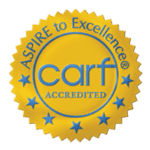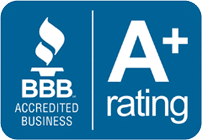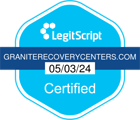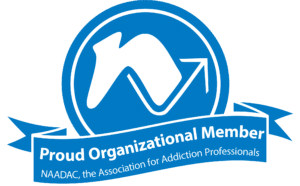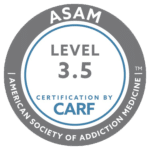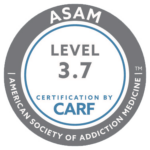Recovering from a drug use problem is no easy feat; it often calls for a multipronged strategy that takes into account the psychological, physiological, and behavioral components of addiction. An evidence-based strategy that has recently gained traction in helping people overcome addiction is medication-assisted treatment, or MAT. This all-encompassing program provides a holistic approach to treatment by integrating medicine with counseling and support services.
What Is Medication-assisted Treatment?
MAT involves the use of pharmaceuticals with counseling and behavioral treatments. Results show that it can lead to positive outcomes like:
- higher rates of survival
- more people staying in treatment
- reduced relapse rate
- allowing those in recovery to find and keep a job
- reducing a client’s risk of contracting an addiction-related infection like HIV or hepatitis C
- better birth outcomes for pregnant people in recovery
MAT is effective because it targets the neurological and physiological components of addiction. By bringing the brain’s chemistry back into harmony, the medications alleviate withdrawal symptoms and cravings. Treatment with MAT stabilizes the client’s condition, allowing them to begin counseling and behavioral treatments that target the emotional and behavioral aspects of addiction. Best of all, this form of treatment works well for many types of addictions, including addictions to opioids and alcohol.
What Are the Benefits of Medication-assisted Treatment?
An addiction of any type is hard to beat. Taking advantage of MAT allows you to access a wide range of benefits that specifically improve the overall recovery process
Easing Withdrawal Symptoms
If you’re experiencing withdrawal symptoms, MAT may help. People often relapse during withdrawal because it is so difficult for them emotionally and physically. For opioid use disorder, MAT options such as buprenorphine or methadone alleviate withdrawal symptoms, making detoxification easier and improving the chances of long-term recovery.
Improved Mental Health
Since mental health issues often accompany substance use problems, MAT takes a two-pronged approach by treating both, making it a lifesaver since it helps stabilize mood and reduce anxiety. When a client’s neurochemical levels are back in balance, MAT improves their mental health and makes treatment and counseling more successful.
Reduce Cravings
People often struggle to stay sober because of overwhelming and long-lasting cravings for drugs or alcohol. By binding to certain receptors in the brain, MAT lessens the intensity and frequency of drug cravings. This enhances a person’s capacity to concentrate on recovery-oriented activities and techniques, making recovery more successful.
Reduced Risk of Overdose
There is less chance of overdosing while using MAT, especially for those struggling with an opiate use disorder. One life-saving measure that is typically included in MAT programs is naltrexone, a medicine that binds to opioid receptors in the brain, suppressing cravings and eliminating the intoxicating effects of opioids.
Addressing Co-occurring Disorders
Many individuals with substance use disorders also struggle with co-occurring mental health conditions. MAT can address both addiction and mental health issues concurrently, offering a comprehensive approach to treatment. By treating the whole person, MAT improves outcomes and enhances the individual’s capacity for sustained recovery.
MAT Medication by Substance Use Disorder
The key to an effective treatment program is to customize it to the exact substances that a person is misusing. There is a higher chance of a successful recovery with personalized therapies since they target specific difficulties. MAT programs modify their approaches based on the specific problems that users are experiencing.
Medications for Alcohol Use Disorder
Nearly 30 million people in the United States over the age of 12 struggle with an alcohol use disorder (AUD). Those who suffer from AUD are unable to limit their alcohol use, even when they know it’s hurting them. It affects a person’s physical health, mental well-being, and relationships.
Addiction to alcohol and other drugs is a vicious cycle that affects many parts of a person’s life and requires extensive therapy to break. There are three medications that treatment providers recommend using during MAT programs for alcoholism.
Acamprosate
One medicine that helps with alcoholism is acamprosate. It reduces the need for alcohol by restoring a normal chemical equilibrium in the brain. After detox, acamprosate is very helpful since it reduces the severity of withdrawal symptoms, which makes staying sober easier.
Disulfiram
Disulfiram discourages alcohol usage through its unpleasant side effects, which include vomiting and nausea when the user drinks alcohol. It serves as an excellent deterrent for those who want to stay sober. Disulfiram offers an alternative to acamprosate by highlighting the negative associations with alcohol use, which helps individuals motivated by aversion-based methods avoid relapse.
Naltrexone
Naltrexone works by reducing the pleasurable effects of drinking to reduce the craving for alcohol. If you or a loved one are allergic to disulfiram, naltrexone is a viable alternative. In contrast to acamprosate, it promotes abstinence via a different mechanism: It targets the endorphin system. Being accessible in both oral and injectable forms makes naltrexone more versatile, which improves its efficacy and accommodates individual preferences and treatment regimens.
MAT for Opioid Use Disorder
Opioid-related deaths continue to rise. From 2019 to 2020, the death rate grew from 47,600 to 68,630. The following year, the death rate went up by another 42,051. Treatment providers typically recommend several different medications to those with opioid use disorders.
Buprenorphine
A medicine that helps with opioid use disorder is buprenorphine. By attaching to brain opioid receptors, it alleviates withdrawal symptoms and cravings without giving users the high that comes with opioids. With buprenorphine, a partial opioid agonist, users can control their addiction more safely, with less chance of overdosing. This medicine is especially beneficial for those pursuing recovery from opioid addiction disorders because of its adaptability and availability in numerous formulations.
Methadone
Methadone stabilizes people with opioid use disorder and helps them avoid withdrawal symptoms by functioning as a complete opioid agonist. It prevents the euphoric effects of opioids and reduces cravings, among other advantages. Methadone is an excellent choice for those with severe opioid dependence since it provides a stronger opioid action than buprenorphine, a partial agonist.
Naltrexone
By inhibiting opioid receptors, naltrexone helps with opioid use disorder by lowering cravings without actually increasing opioid levels. As an opioid antagonist, the medicine does not replace opioids but rather blocks their effects, in contrast to methadone and buprenorphine. Naltrexone also comes with a lower risk of dependency or addiction.
Naloxone
In contrast to methadone and naltrexone, which are primarily used for long-term treatment, naloxone is a life-saving, emergency-only intervention that is to be used when a person is actively overdosing on opioids. Naloxone rapidly reverses the effects of opioids, restoring normal breathing and consciousness.
Suboxone
Doctors who treat opioid use disorders often prescribe Suboxone, a medicine that combines buprenorphine with naloxone. Together, they make recovery less dangerous by lowering the possibility of diversion and abuse. As a crucial tool in complete treatment programs, Suboxone helps clients on their road to opioid recovery.
Vivitrol
Vivitrol is an extended-release version of naltrexone. It minimizes cravings and stops the pleasurable effects of opioids by blocking opioid receptors; it usually comes in a once-a-month injectable dose. Clients are more likely to stick to their treatment regimen because Vivitrol lasts so long. And because it doesn’t require frequent dosing like other drugs, Vivitrol is a good option for those who have trouble taking their prescriptions as prescribed.
How Well Does Medication-assisted Treatment Work?
MAT is an excellent choice for those suffering from alcoholism or opioid use disorders for many reasons. This type of treatment makes recovery easier by reducing withdrawal symptoms and cravings. Additionally, MAT treats each client uniquely because of its customized nature, which allows for personalized treatment strategies. Finally, MAT increases treatment retention rates by decreasing the likelihood of relapse. Patients can get diverse assistance on their journey to sustained recovery when combining prescription medicines with counseling and therapy, creating a whole-person strategy.
Myths About Medication-assisted Treatment
Myth: Methadone maintenance treatment (MAT) adds another addiction to the mix.
Reality: When taken as directed and under close supervision, MAT does not add another addiction to the mix. Instead, this type of treatment helps people in their fight against addiction by reducing the severity of withdrawal symptoms and cravings.
Myth: MAT works well only in extreme situations.
Reality: Individualized MAT helps those with moderate-to-severe addictions recover over the long haul.
Myth: MAT is a quick solution.
Reality: The truth is that MAT is not magic and that recovery takes time. However, when used as part of an all-encompassing treatment strategy, MAT boosts the efficacy of counseling and therapy, which aids in the patient’s long-term rehabilitation.
Myth: MAT is a one-size-fits-all treatment approach.
Reality: MAT doesn’t come in a one-size-fits-all program. Instead, it requires individualized therapies that specifically target each client’s unique needs.
Myth: MAT is only for opioid addiction.
Reality: MAT works well for many types of addiction, including opioid-related disorders and alcoholism.
Getting Help for Addiction with Medication-assisted Treatment
Granite Recovery Center is dedicated to providing personalized care and all-encompassing assistance, making it an excellent choice for anyone seeking treatment for substance use disorders. Granite stands out by offering personalized MAT programs, recognizing the unique needs of each individual. This strategy ensures a comprehensive treatment path by combining evidence-based drugs with counseling and therapy. Our primary goals are to remove obstacles to treatment, make programs easily accessible and address the mental, emotional, and physical elements of addiction. Call 855.712.7784 today!

